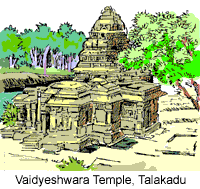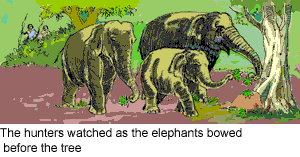
Dimdima
Online Children's Magazine from India

Dimdima
Online Children's Magazine from India
It is believed that at Talakadu there are thirty temples submerged in the sea of sand. The temples which are still visible above ground are the Pataleshwara and Maruleshwara(built by the Gangas), the Keertinarayana (Hoysalas) and the Vaidyeshwara (Cholas). Puja is still conducted in these temples, especially during the Panchalingadarshana festival which takes place every 12 years in November-December. This is the only time that Talakadu is visited by thousands of people.
The Pataleshwara and Maruleshwara temples are the oldest. The shivalingam installed in the former is said to change colour — from red in the morning to black in the afternoon to white in the evening.
The Keertinarayana temple has a 3-m-tall idol of Vishnu, which is still in worship.
 The largest and most ornate temple in Talakadu is dedicated to Shiva as Vaidyeshwara or the Lord of Healing. Though the temple seems to have been built in the 14th century, a puranic legend suggests an earlier date. According to the story, a sage named Somadatta and his disciples, while doing penance on the banks of the Kaveri to propitiate Shiva, were killed by wild elephants before they could complete their spiritual quest. They were reborn as elephants in the same forest. To help them, Shiva took the form of a lingam buried beneath a silk cotton tree. The elephants would bathe in the Kaveri and offer lotuses at the foot of the tree every morning.
The largest and most ornate temple in Talakadu is dedicated to Shiva as Vaidyeshwara or the Lord of Healing. Though the temple seems to have been built in the 14th century, a puranic legend suggests an earlier date. According to the story, a sage named Somadatta and his disciples, while doing penance on the banks of the Kaveri to propitiate Shiva, were killed by wild elephants before they could complete their spiritual quest. They were reborn as elephants in the same forest. To help them, Shiva took the form of a lingam buried beneath a silk cotton tree. The elephants would bathe in the Kaveri and offer lotuses at the foot of the tree every morning.  This ritual was observed by two hunters named Tala and Kada. Curious, they tried to cut the tree down, but at the first blow of the axe, the tree began to bleed. A voice instructed them to dress the wound with the leaves and fruits of the same tree. When the hunters obeyed, the blood turned to milk, which they and the elephants drank and became immortal. Later, a temple was built around the shivalingam and the place came to be called Talakadu after the hunters!
This ritual was observed by two hunters named Tala and Kada. Curious, they tried to cut the tree down, but at the first blow of the axe, the tree began to bleed. A voice instructed them to dress the wound with the leaves and fruits of the same tree. When the hunters obeyed, the blood turned to milk, which they and the elephants drank and became immortal. Later, a temple was built around the shivalingam and the place came to be called Talakadu after the hunters!
Though the forest department has planted trees to prevent the desert from advancing, it is still encroaching at the rate of 3 m a year. The source of the sand is the Kaveri itself. All the silt and sand deposited in the river bed and on the banks during the dry summer months are blown on to the city by the winds of the south-west monsoon. The river may also have changed its course many times in the past, leaving the sand behind. Whatever may be the reason, the curse or nature's course, Talakadu is today a rarely-visited, almost forgotten city.
Last updated on :11/3/2003
Dimdima is the Sanskrit word for ‘drumbeat’. In olden days, victory in battle was heralded by the beat of drums or any important news to be conveyed to the people used to be accompanied with drumbeats.
Bharatiya Vidya Bhavan
K. M Munshi Marg,
Chowpatty, Mumbai - 400 007
email : editor@dimdima.com
Bharatiya Vidya Bhavan
505, Sane Guruji Marg,
Tardeo, Mumbai - 400 034
email : promo@dimdima.com
Dimdima.com, the Children's Website of Bharatiya Vidya Bhavan launched in 2000 and came out with a Printed version of Dimdima Magazine in 2004. At present the Printed Version have more than 35,000 subscribers from India and Abroad.